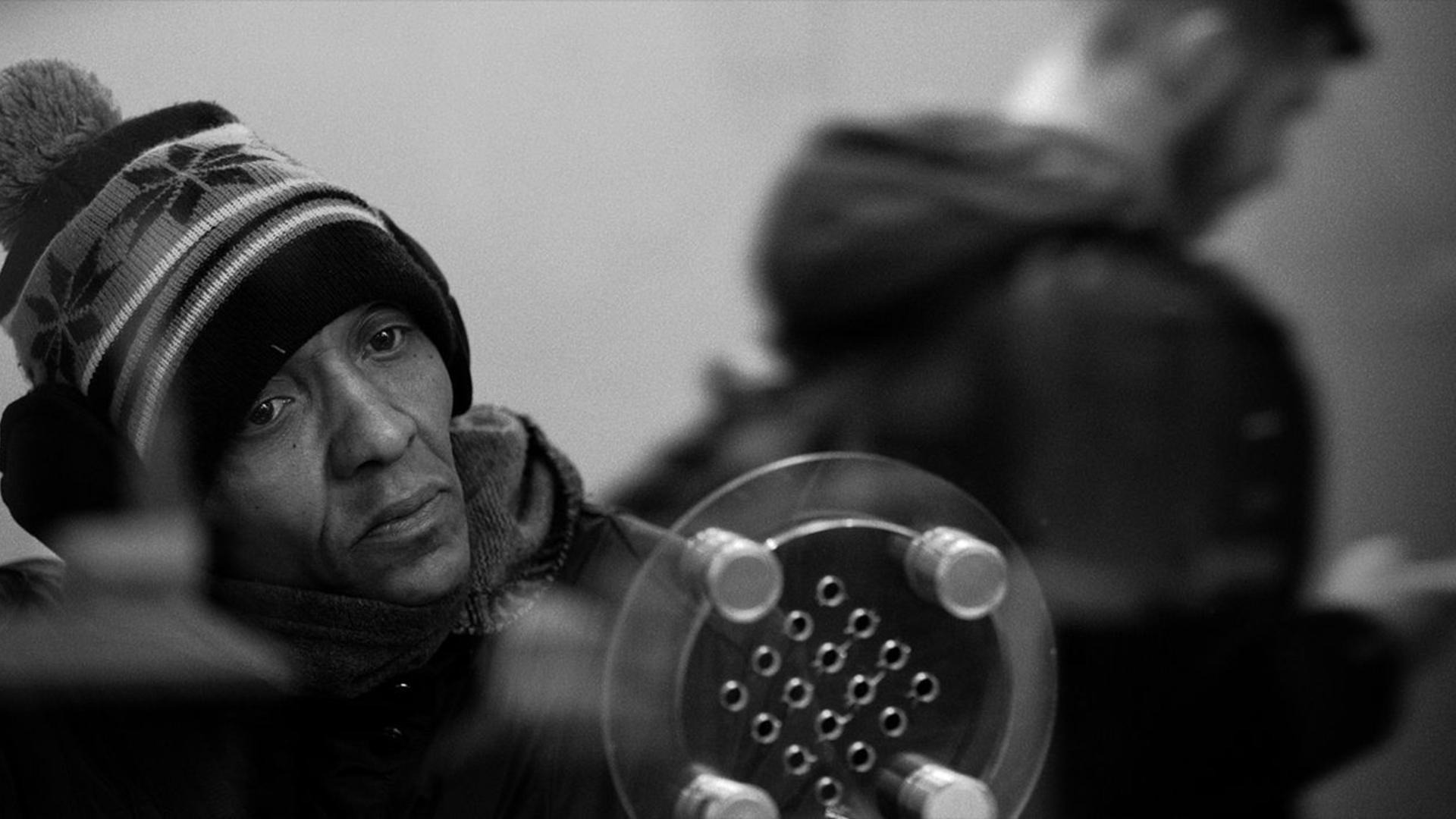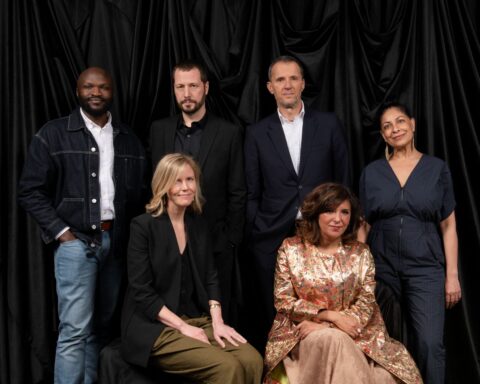“In my previous films, there are always encounters with people by chance, just like running into someone on the street. That’s always part of my work,” says director Jean-François Lesage. “Documentary filmmaking for me is an excuse to discover other people’s lives and invite myself and my team inside their houses and knock at every door.”
Lesage’s latest documentary, A Prayer for a Lost Mitten (Prière pour une mitaine perdue), feels like a contemporary time capsule. Shot in the snowy winter of Montreal and in the city’s bustling Métro, one can’t help but feel nostalgic while observing the array of happenstances and chances encounters. This poignant elegy for human connection reminds one of a distant past in which one could approach a stranger on the street, rather than scurry away from them during this prolonged period of social distancing.
The film, Lesage’s fifth feature as a director, marks his first time as an official selection at Hot Docs after his previous films A Summer Love (2015) and The Hidden River (2017) won the Grand Prize for Best Canadian Feature and Special Jury Prize for Canadian Features at RIDM, respectively. Prayer for a Lost Mitten adds another trophy to Lesage’s mantle as the winner of Hot Docs’ award for Best Canadian Feature. Although Mitten has a distinct Montreal flavour, its reflection on love and loss is universal.
View from a Booth
Lesage says that Prayer for a Lost Mitten draws inspiration from his fascination with chance encounters through exploring questions of loss that strike individuals. The film observes various Montrealers from within the lost and found booth of the Métro (STM). Lesage’s camera watches as commuters approach the glass and inquire about a lost pair of glasses, a missing toque, or a misplaced subway pass. Fairly often, the commuter shares a personal story with the STM employee as if they need to justify their desire to regain some lost keys or clothing.
The film surprisingly doesn’t go below ground to ride the subway with the commuters, but Lesage says the choice to remain above ground was both practical and artistic. “I remember a Taiwanese movie called Murmur of Youth and it was only in a ticket booth,” explains Lesage. “Most of the scenes were interaction between two people selling movie tickets in a booth. I liked the idea that we would be confined to the STM office.” The film follows several commuters outside the metro to learn more about their lives, the stories behind their missing items, and the greater narratives of loss that echo throughout their experiences as the film moves from considering material to immaterial losses. For the ones we see only from behind the glass, the approach leaves one wondering about the untold stories within the bins of forgotten items.
Although Lesage admits that some people left funny things behind in the lost and found, the items themselves were not the focus. “We spent two days in the lost and found and then I chose around 30 people that I would want to follow,” explains Lesage. “We told people we might contact them again for an interview and we might want to follow them in the difficult winter months, like January and February, at night doing outdoor activities.”
Nostalgia en hiver
The film’s gorgeous black and white cinematography captures the Montreal cityscape beautifully as the snow contrasts vividly with the night sky. A wistful jazz soundtrack by Tom Brunt further accentuates the themes of love and loss evoked by the stories and images. “The film is about loss and the longing to find something back, so I thought, let’s be completely nostalgic,” explains Lesage. “Let’s be inspired by great films in black-and-white from the ’60s, like Gilles Groulx’s Le chat dans le sac, which had jazz music by [John] Coltrane.” While Groulx’s classic film inspires the soundtrack, Lesage says the visuals pay homage to La vie heureuse de Léopold Z by Gilles Carle. “It’s shot during a big snowstorm in Montreal,” explains Lesage. “I really wanted to find that texture—that melancholy and nostalgia from cinema of the ’60s.”
The director says that shooting in winter usually poses a challenge for him, especially when it comes to finding characters while roaming the streets, but that shooting Prayer for a Lost Mitten during cold winter nights showed him the resilience of Montrealers. “It was really nice to see that on the Mount Royal, there would always be a few people skiing and a few people out walking. I was impressed by the Montrealers and how active they were in very cold winter nights.” Getting out and finding energy in the crispness of winter is one of the ways in which Lesage says the project inspired him to look at the city anew.
Finding Characters and Relationships
Lesage says that Montreal’s character is further evident in the candour the film enjoys with its participants. “In Montreal, people are really open to being in artistic projects in general,” observes Lesage. The director says that casting for Mitten came much easier than in it did with his previous film A Hidden River where the residents of Gaspésie were reluctant to speak with an outsider.
The film gradually builds relationships with the Montrealers, witnessing them at a remove in the STM booth, then following up with them in their homes for interviews in which their lost items lead to wider conversations, and then outside into the city and back home for dinner parties or cinq à sept aperitifs with friends. “They met the crew at least three times,” adds Lesage, “so by the time we shot the dinners, they knew us a little bit.”
For Lesage, the sequences that extend the characters’ social circles ultimately reveal more about people and city life. “You often get the best tales and best parts of the conversation after spending four hours with them,” says Lesage. “People are not necessarily very natural with us, but when it’s the third meeting and then the last hour of that dinner with friends, they forget themselves.” The pattern with the interviews creates a natural progression as the lost items are replaced by palpable feelings of connection, conviviality, friendship, and intimacy.
Documentaire de création
Although Lesage’s brother Philippe is also a filmmaker—they co-directed the 2010 documentary Can You Tell If the Little Fish Are Happy? before Philippe found international acclaim with films like The Demons (2015) and Genesis (2019)—the director says that they weren’t raised by cinephiles. Following in the path of his journalist father, Lesage worked as a reporter for CBC-Radio Canada in Western Canada, but found himself continually annoying his superiors by exploring the visual aspects and the role of music in storytelling. Lesage adds that his interest in creative approaches to documentary partly stem from his background in journalism.
“From one film to another, I am less shy to intervene and to provoke some meetings,” explains Lesage when asked about his approach with interviews and observational style. “For example, when I asked these people, ‘Can you please invite all your friends on Friday night and cook dinner for them?’ I’m less hesitant to get involved in the mise-en-scene. In Europe, they talk about documentaire de création, or creative documentary, and I really like this idea that you start from reality, from what you observe with real people and real conversations, but then, especially in the editing, you can be very creative.”
Curiosity and Connection
The film plays with the mundane elements of city life that give Mitten its resonance. Seemingly inconsequential objects, like toques or photo ID cardholders, carry great significance for some characters where losing the item is like losing a loved one. This process comes through Lesage’s curiosity with the everyday people and their stories. “I like the idea that anybody can be the topic of a documentary,” observes Lesage. “This is a question of how you look at a person. I never look for very eccentric characters—I might find one by chance on the street—but I look for the banal, what we think is ordinary, and try to reveal it with different perspectives.”
The revelations that arise through ordinary conversations and mundane objects are unexpectedly touching as one watches Prayer for a Lost Mitten in a strange period with an absence of human connection. When asked if the images of social interaction and city indeed make the doc a time capsule, Lesage remains optimistic. “I think the film has gained some gravity with what we’re going through right now,” he admits. “We are all touched in different ways. We question the things that we take for granted. The readings of the film could be different in this period now. When we look at these dinners, we might think Oh, la la! I hope we get back to that time where we could have dinners and we could get together.”
Prayer for a Lost Mitten screens at Hot Docs’ online festival beginning May 28.











